The difference between a functional sales team and a stellar one is enormous. It could be the fine line between surviving or smashing revenue targets out of the park.
No one sets out to build a mediocre team. Sometimes it just happens that way over time.
There are many reasons why you might want to take the time to re-evaluate your current team—or else plan to build a new one from scratch:
- Rapid company growth requires more specialized sales talent (or in the case of many startups, the transition from CEO/Founder as the sole salesperson to building a dedicated sales team).
- Launching into a new market
- Staff turnover leads to a requirement for new hires.
In this guide, we have put together a list of tips and best practices gleaned from sales directors who have built highly successful teams. These tips will help any business looking to increase sales performance rapidly.
Contents
- Building Your A-Team
- Building Your Sales Machine
- The Need for a Sales Infrastructure
- Managing Your Team
1. Building Your A-Team
From sales managers to company culture, there are many factors that go into the framework of finding the best sales personalities and moulding them into a cohesive unit that exceeds targets.
The Basics
No Good Team Exists Without a Great Leader
- A successful sales team needs an inspiring leader to drive everyone forward and ensure targets are met.
- The best bosses affect change, creating actionable tasks that improve the skills of their staff members, professionally and personally.
- They understand that the bigger picture points to a well-knit group of individuals that come together to form a top-level team.
- Staff behave in a manner that relates to the atmosphere created by the manager. Through a combination of leading by example and experience, bosses portray qualities that motivate their staff.
- Sales managers set the tone, both consciously and in subtle ways.
Creating the Best Atmosphere
Personal attributes aside, the best managers build the groundwork for a successful sales team by creating an environment for them to thrive in. Transparency is a good starting point, as it will help build trust.
They should reward staff when they have performed well. Recognizing accomplishments lends itself to a positive working environment where everyone feels valued. These can come via small details like acknowledging good work and rewarding staff with incentives when they exceed expectations.
Celebrating success promotes worth. Even the best reps still need to hear they are doing a good job from time to time—it helps to relieve pressure.
Spirits stay high, and staff are motivated to do the best job possible.
Building a Reputation
- Word travels fast when it comes to the working culture—no matter the industry. A bad professional environment can lead to a poor reputation, which then makes it harder to attract top talent.
- A good reputation will do the opposite, however. All staff members want to work in a proactive, positive setting where they feel liberated to thrive.
- It will be easier to hire the best staff if the company becomes known as a place where sales reps desire to work.
- Perfecting the company culture isn’t one-dimensional; it’s two-fold.
- Reps under your setup will be able to thrive, while the ones working for other companies are likely to start making eyes in the direction of your business.
Recruiting High-Level Reps

Establish the traits of a good leader, then fill your sales roles with the most suitable reps.
Simple, right?
Of course, there are more nuances that go into the process...
Qualifier. Closer. Both.
Understanding the defined role of your staff is an essential component of building a killer sales team. Once you know the type of roles, the next aspect involves finding a good fit.
“Avoid hiring reps from Fortune 500 companies”
Many sales managers are tempted to go for high-level reps from Fortune 500 companies. This isn’t always the best fit for a company, however. An A-star closer might seem better on paper than reps with less experience. But if they are coming from a leading brand, there is a chance that they haven’t needed to exert themselves too much to sell a product.
In smaller companies, selling the vision often holds as much weight as the product. A-star reps will likely be used to having extensive resources at their disposal, which is something they won’t get in smaller setups.
Much of the decision-making process around your hires relates to where your business stands financially and the outlook of its growth forecast. Unless you’re the VP of Sales at Google, you probably have to make budget concessions when hiring top-level sales managers.
How to Avoid Random Recruiting: Scorecard
Despite looking through CVs and interviewing candidates, employers often hire based on their gut feeling. Those applying for a role might be interviewed by two or three separate people who are impressed enough to trust in their instincts. Yet, they don’t have a clear indication as to whether the candidate will be a success.
To be more thorough in the recruiting process, build a scorecard—a single-page document that contains four sections. The first is the mission, which is a short statement of one to five sentences that describes the key role.
Next, define the job target by developing three to five specific outcomes that candidates must accomplish to fit the requirements for the position.
Examples might include:
- Convert X amount of leads within a six-month period.
- Build an outbound team within the next nine months.
Expectations should be high, yet achievable. Low performers will be automatically disqualified from the process. However, if goals are unrealistic, candidates will think that you are making outlandish expectations. The knock-on effect of this will make it impossible to find the best candidate.
The third step involves creating as many role-based competencies that you believe someone should possess to achieve success in the role. Competencies to look for in sales reps include being proficient at cold calling and a willingness to learn.
Define the main traits that describe your company culture and add those to the scorecard.
Company ethos you believe could entail:
- Customer-centric
- Honesty
- Speed
- Efficiency
- Competitiveness
Try to be objective and ask existing employees to provide words and phrases in relation to how they see the company culture.
Finally, show your scorecard to the other people involved in the recruiting process to see if it aligns with the role. By using a scorecard, everyone involved knows which questions to ask candidates and what aspects to test. Your hiring decision will be based on real information, not just gut feeling.
Extra Tip: Share your scorecard with recruiters if you are using them.
Hunger, Willingness to Learn, and an Ability to Listen
If you’re a startup or an early-stage business, going for salespeople with an edge could prove to be the best route forward. That doesn’t mean finding personalities that are hard to work with or lone wolves. But it does involve finding those who have faced and overcome previous struggles.
You want people to possess two key traits: hunger to succeed and a willingness to master. Discover candidates who are sponges—ready to absorb information. Not only will it help them learn about the company, but it will also put them in good stead when dealing with leads.
"The art of selling comes down to an ability to listen."
While many reps believe they need to talk to sell a product, it’s those that listen to their customers’ pain points who will prosper.
Leader Within the Team
It’s all well and good having an excellent sales manager, but they can’t do it alone. The best teams feature staff members who thrive when taking on an extra layer of responsibility. They hold themselves accountable—both individually and within their wider role in the group.

These reps are in regular communication with their managers, providing updates with an overview of current objectives. Not only do staff members with these traits add to the overall quality of a sales team, but they are also likely to make good future managers.
Define and Match Your Company Values
As a manager, it’s important to recruit people who fit into the company culture and align with the values you have created. Everyone needs to pull in the right direction for there to be harmony and cohesion.
Hiring someone who isn’t a good fit for the organization could spell trouble for the team in the long run. Even if the hire is good at selling, there still needs to be an overall fit within the wider structure of the group. Don’t underestimate the importance of a good fit—include it in your scorecard.
Onboard Your New Salesperson
Recruiting takes plenty of time and energy. Don’t lose that energy by incorrectly onboarding new hires. This point will be discussed later in greater detail, but finding a rep is not the end of the road—it’s the beginning. You need to understand their qualities as soon as possible, so you have to onboard them as effectively as you can.
Use Metrics to See How New Hires Perform (and Get Rid of Low-Performing Ones)
When you first hire someone, it can be hard to tell whether they are suited to the role if you only measure success by the leads they’ve won and the revenue generated.

Instead, focus on smaller actions—like activity-based metrics and intermediate KPIs. Monitor how they behave on calls, how many meetings they acquire, and the amount of leads they’ve qualified; ask to be bcc’d into emails and look at how they progress a lead.
This will save valuable time as you can’t wait six to nine months to find out if a sales rep is any good, at which point you will need to find another one.
Give your sales team the best tool to manage leads and close more deals effortlessly.
Start your free trial
Structuring the Sales Team
From a Founder Sale to Scaling a Team
When a company is still in the early stages of taking a product to market, you aren’t necessarily selling your product—you’re conveying the story of your product or service and the problem it solves. The aim is to convince people to be part of that story. All commercial activities are often led by the founder, as they are the best person to tell the brand story.
Once you understand the intricacies and framework of selling your product or service, you then want people who are capable of selling it for you. At this stage, hiring two to three sales reps who can learn from you becomes necessary.
Now that you have a few team members and are generating revenue, it’s time to scale your sales process. You understand how to sell your product and have nailed down a process that achieves results—it’s time to see if it works across a team.
There will be some room for diversification as you adapt to having a team. The goal is for you and your team to understand the metrics required to succeed and segment roles so staff specialize in areas where their strengths shine.
Have a Clear Sales Process
Not only does a clear sales process help with onboarding new staff, but it also serves as a blueprint for all reps to achieve success. Not everyone can be a top salesperson, but that doesn’t mean they can’t be effective. This is where the sales process comes into play:
- A well-defined process enables all staff members to close deals and perform better.
- It acts as a structured method for onboarding new staff members seamlessly.
- There must be an organized and easily accessible way to engage with each new incoming prospect.
- Take appropriate steps to qualify prospects and turn them into customers.
Turning Your Team into Specialists
“Having a handful of specialist sales reps is generally better than a dozen or so all-rounders.”
On paper, it’s easy to assume that power lies in numbers. A team of 10 to 20 reps might initially seem like a good idea. However, it could also indicate a setup that is still figuring out its best sales process—one where no one is specialized.

On the other hand, a team of five to 10 reps might be better positioned to achieve quicker results—especially if each one knows the exact metrics and individual KPIs needed for success.
You can segment with just two people if you have a solid understanding of the makeup of what you’re selling. Once you have the metrics and know your market, you can accelerate at full speed—whether with a team of two or 10 salespeople.
Understanding Strengths and Weaknesses
It’s vital to understand the personalities within your team to determine their strengths and weaknesses. Find out what makes them tick—teams with managers who take time to understand the psyche of their staff tend to perform at a higher level.
- Who is good at qualifying?
- Who excels at closing?
- Who is better at prospecting?
- Who is better at managing and growing existing customers?
That’s also why building a scorecard when recruiting is important—you want someone to fit a specific role.
If possible, split the team into sections, with some working on the opening stages of a sale while others handle the final phases.
Managers need to leverage their own strengths to identify traits in their team. It’s up to the manager to not only pinpoint the strengths and weaknesses of their staff but also accentuate strengths while mitigating weaknesses.
2. Building Your Sales Machine
Building an effective sales machine indicates a rock-solid process that enables you to accurately predict outputs (sales, profits, etc.) based on inputs (number of meetings, calls, team members, etc.).

Nailing down this process allows you to:
- Rapidly scale.
- Achieve revenue targets.
- Help the team operate at its most effective.
But how do you build a sales machine in your business?
Selling is a Process
Make Your Sales Process Efficient
There is no process without leads, which come from inquiries. The first step is response time and the contents of that initial conversation.
You should respond to any inquiries as soon as possible—never take longer than 24 hours.
Once you respond, it’s time to qualify their needs and determine if they are a good fit. Work with your team to develop a list of pre-qualifying questions to filter the best prospects:
- Ask about budget.
- Find out the purchase timeline.
- Are you speaking with the decision-maker?
- Ask technical questions centered around the product/service that may be necessary for the sale.
If you get positive answers, send a follow-up email with a product presentation.
After the email, jump back on the phone and schedule an appointment for a live demo. Outline an oral proposal to illustrate the presentation during the meeting. If all goes well, create a written plan and send it to the client.
Visualize the Sales Funnel of Your Pipeline
Executing the physical steps of a deal is the primary goal, but it helps to visualize selling a product/service. The sales funnel helps reps focus on their goals with more clarity and is a way to predict some elements of the process.
Overall, your funnel acts as the foundation for your process and helps strategize taking leads from the initial prospecting stage through to becoming customers. There will be greater visibility over deals in progress, and you can look deeper into your sales funnel for long-term strategies.
Identify Roadblocks
Pipelines also help identify potential roadblocks in deals. Managers can step in halfway through a deal if it’s going south and guide it back on track.
It’s also worth analyzing to see if blocking points occur due to the number of pipeline steps you’ve defined. It might be that you have too many or too few steps.
- Not enough steps mean the process is probably too fast and may leave reps feeling a sense of urgency and that they need to rush deals.
- Too many might end up becoming time-consuming and challenging to manage.
A visual sales pipeline helps you come to these conclusions sooner, avoids time-wasting and makes the team more efficient.
Focus on the Best Leads Through Scoring
Focus on Real Leads
Loading prospects into the pipeline and hoping they convert feels good. But that initial joy will soon turn to frustration if you overload the pipeline. Especially if they don’t amount to much.
“Less is more when it comes to prospects that are likely to convert”
Quality, not quantity, is the name of the game. Focus on the leads that you know have the best chance of converting. Less is more when it comes to prospects that are more likely to convert. Streamline your pipeline, so only the best leads remain.

There are times where you can act on your gut feeling—if it’s positive. Follow up on your instincts—even if it doesn’t appear to fit your necessary criteria. Go with your implicit feeling and refine the analysis afterwards.
Define Your Perfect Customer
What does your perfect customer look like? It’s important to identify key traits in your prospects so you have a better idea about which deals will close. Your best customer is a combination of several different criteria:
- Does your product/service solve their pain point?
- Do they generate enough revenue for you?
- How hard are they to close?
- Will they grow over time?
- What is the risk of losing them?
- Do you perform better in specific industries?
Defining your perfect customer is vital to building a road map that helps you find similar ones in the future, instead of prospecting random companies.
Build a Prospecting List and Reach it Systematically
One of the key aspects of prospecting is finding potential leads for your reps. A good way to start is by making a list of companies that you think are worth reaching out to—ones that look like your perfect customer. Share that list with the cold calling team so they can begin initial contact, or use marketing automation software to initiate contact. This is something all companies should do, no matter the size. Smaller organizations should also adhere to this process; it only takes three people to have one marketer, one caller, and one closer.
Qualify Your Prospecting List
When doing cold calling, each call should give you additional information on your prospect. Even if you don’t get the target person on the phone, you can use the call to validate some information:
- Size of the company
- Location
- Sector of activity
- Actual position of the person you are trying to reach
Once you are in contact with the correct person, ask about the solutions they currently use to see if there is a hunger for a new product. If they don’t already have a solution in place, instead of offering yours straight away, ask why they aren’t using anything.
There are obviously factors like budget and decision makers to take into account, but before you even get to that stage, it’s important to know if there is a good fit between prospect and product.
Score Your Leads
It’s all about the leads. But not any old lead will do. Qualifying your prospects through various means is essential to score them and cut through the noise.
There are plenty of ways to score a lead: define different criteria, rate your leads against those criteria, and add all the subscores to create a global score of the lead. Try the red flag approach: Define different red flags, and if one appears, move swiftly onto another lead.
Red flags can be:
- The company is too big to use your product/service
- No budget
- Not the right problem/solution fit
- Account is too small with no potential
It is vital to determine whether a lead is low quality or has no chance to close. Doing so will save you time and help your sales team focus on the right leads.
3. The Need for a Sales Infrastructure
Align Marketing and Sales
“For every dollar spent on staff, you should invest another in the sales infrastructure”
Sales reps are only as good as the information they have, so it’s important that you build an infrastructure around them. You should invest equally in the team and the setup. For every dollar spent on staff, invest another in the sales infrastructure.
Make Your Sales Process Efficient
A significant amount of leads generated by inbound campaigns is also an indication that your marketing efforts are performing at a high level.
Sales and marketing need to work together to have a clear, consistent messaging architecture. Marketing shouldn’t promise something that reps can’t deliver. Messaging should be reflective of each stage of the user journey.
It is not the role of your salespeople to find prospects; it’s the responsibility of your marketing team.
Goals should be set for marketing to generate a specific number of leads per month. There are plenty of ways to generate leads and push forward the demand for a product or service. None are easy, and you have to find your best acquisition channels. Try, learn, try, learn, and try again.
Even in smaller companies, where marketing resources aren’t as vast, there should be a plan in place. Every company needs a structure that brings inbound leads.
Different ways of generating leads:
- Company website
- Paid search campaigns
- Marketing automation
- Downloadable case studies
- Social media outreach
- SEO
- Blogging
- Display and print advertising
- Marketing databases
- Events
Equip Your Sales Team With Arguments
Customers intending to use products—and who genuinely want to solve their pain points—will have plenty of questions about a product or service. It’s good to receive questions, as it means there is genuine interest in what you’re selling.
“Being ready to deal with frequent customer objections is also essential for reps to be able to progress the sale to the next step.”
Having the right answers is even more important. Most businesses equip themselves with key arguments to counteract the common questions around the product. Being ready to deal with frequent customer objections is also essential for reps to progress the sale to the next step.
Your marketing team should provide your sales team with:
- Common objection handling
- Strengths and weaknesses of your competitors
- Good marketing content
Find the best arguments for your product or service, including the use of ROI statistics, awards won, and customer testimonials. Customers are only going to invest in a product that they think is certified. They need to believe it solves a problem they have in the long term.
Using stats and data gives credibility and supports the good things you want to say about a product/service.
Data and statistics act as a safety net for customers and are often the difference-maker that helps push a customer over the line when making a purchase decision.
Train Your Sales Team. Then Train Them Again
Training is one of the key ways to improve the performance of reps. Whether through individual coaching, a mentor program, internal training, or sending reps on courses, all sales departments should invest in continuously improving their staff.
External training options that involve the whole team can be particularly beneficial as they enable bonding and learning new skills.
Explore the idea of setting aside a day or two every couple of months to take the team offsite. This should help build overall skills and confidence.
Use internal training by looking at the best-performing reps and then teaching their qualities across the team. Identify their positive traits and incorporate them into your internal training methods.
Share their cold emails, the way they start a call, or how they close a deal.
Give Your Team the Tools They Deserve
Sales IT
The modern-day salesperson is as reliant on sales software as they are on their personal skills. In this day and age, reps are spoilt for choice as far as technology is concerned. There are a plethora of options on the market.
 - Video conferencing software means more meetings can take place without the need for physical interactions.
- Video conferencing software means more meetings can take place without the need for physical interactions.
 - VoIP calling software affords the opportunity to record, monitor, and analyze phone calls. Recording calls helps to understand how your best reps perform and how you can improve other reps. VoIP is often a cheaper alternative to regular cellular plans, too.
- VoIP calling software affords the opportunity to record, monitor, and analyze phone calls. Recording calls helps to understand how your best reps perform and how you can improve other reps. VoIP is often a cheaper alternative to regular cellular plans, too.
 - Website tracking software helps marketing departments analyze the behavior of website visitors and understand which companies are visiting your site. This allows for smarter marketing outreach and a higher quality of leads.
- Website tracking software helps marketing departments analyze the behavior of website visitors and understand which companies are visiting your site. This allows for smarter marketing outreach and a higher quality of leads.
 - Calendar booking software is a huge time saver and increases the chance to schedule meetings.
- Calendar booking software is a huge time saver and increases the chance to schedule meetings.
 - Document management and tracking software is essential for delivering high-level proposals, as well as knowing when they are opened in real time.
- Document management and tracking software is essential for delivering high-level proposals, as well as knowing when they are opened in real time.
And that’s without mentioning CRM, lead management software, or ERP.
Arm Your Team With the Correct Sales Tools
Place less emphasis on the individual and more on the sales tools required to empower them. The idea is to build a process that has the right tool at each step and provides staff with an ability to perform their job better.
There are an array of tools available to reps; you don’t need them all from the very beginning, however. Choose ones that are the most relevant and helpful to your sales team.
A centralized information system to follow your deal flow is the most important piece of technology you need (after an email and phone, of course). Having a centralized system also curtails the majority of issues that arise from staff turnover. You don’t lose ongoing business when someone quits, and it’s much easier to onboard new reps.
Start by choosing a software to manage your prospects and deal flow. Then add the other tools that you think will grow your team’s efficiency and your business.
Choosing the Right Sales Management Tool
All sales teams need a system where reps can see all their prospects, current deals, which actions to take, and the next step. It’s also important for managers, who can centralize the information into one place and follow their team’s activity.
There are different aspects to take into account when looking for such a system...
It Must be Visual
The interface needs to be clean and provide simplicity—that goes without saying. Staff will shy away from something that looks confusing. The tool should be easy to use, and the look of the overall product will play a major role in whether they interact with it or not.
Sales Reps Must Use It
There is no point in having a sales tool to help reps if they don’t actively use it. Many companies believe a CRM is the best route for managing leads. Yet salespeople don’t use them because they’re too complicated.
Reps see them as a reporting tool to management rather than a genuine method for moving leads through the pipeline.
The result means they don’t fill them out correctly, and the information is not up to date. Sales reps don’t use them and therefore don’t know which action to take with their prospect.
Instead, reps need a tool they want to use, one where inputting data isn’t a chore.
You Don’t Need a CRM
Many companies fall for the CRM trap. And it’s easy to see why: The large CRM organizations spend time and resources to appear as the de facto solution for managing leads.
There are many different tools on the market
Take some time before deciding on a sales solution. Ask what you need it for—what do you want to achieve by using the software?
If it’s managing leads and having a definite, actionable next step so your sales team always knows what they’re doing, lead management software is more suitable.
Lead management software strips away many of the layers and focuses solely on moving leads through the pipeline. There is now more of a desire for software that fits specialist needs, as opposed to something that ticks many boxes yet doesn’t provide an optimum solution.
Selling is a process—it’s about moving a prospect from the very first contact to the moment where you turn them into a customer. You need to manage a process. CRM is more about managing data; they are more static, which is why they don’t help salespeople.
4. Managing Your Team
Setting Goals and Motivating Performances
The best reps have something to work towards—a realistic goal that motivates them to succeed. Those goals come from management that can motivate performances and create an environment where their staff excel.
“You can’t ask your sales staff to go out and bring in one million dollars.”
One of the key mistakes many organizations make centres around them thinking that revenue-based goals will help salespeople. In fact, you can’t ask your sales staff to go out and bring in one million dollars. If they could, they wouldn’t be working for you in the first place.
But you can tell them to find 50 prospects, visit 15, and send 10 proposals per week. Looking at the bigger picture of the sales machine, you need to analyze the input target (cold leads, etc.), which will help reach the goal of the output metric (deal conversion).
As a manager, you have to do reverse engineering on your sales process. If your average customer spends $50k, and your conversion rate is 10 percent, you know that sales reps need to interact with 200 prospects and convert 20 into customers to make a million dollars.
It’s similar to a sporting setup: You can’t tell your team to win the championship. Instead, you need to know the requirements that enable them to do their job. If everyone on the team knows which competency is specific to the role they have to improve, there is a higher chance of winning the championship.
If the input is good, the revenue will take care of itself.
Which Metrics Should You Review With Your Team During Sales Meetings?
There are many different metrics that can be used to measure the performance of your team. Here is an example of three key metrics that you can track on a regular basis.
Number of Meetings
There is no business if you don’t reach out to potential customers. Nothing is going to happen, and you can’t sell your product. Find a realistic target for the number of meetings your staff should make each month. The answer will depend on the size of the company, but it’s important not to get too carried away with expectations.
Number of “Live” Opportunities
Which opportunities are “live”? These will be further down the line than initial outreach, with leads showing an interest in the product. You want a healthy number of live opportunities each week that can realistically convert to deals.
Number of Won Leads or Verbal Commitment
Which customers are saying “yes” to your product, and how many are doing so each week? This is a key metric as it indicates that everything else you are doing is working. Be sure to verify that verbal commitments match with the number of deals signed and invoiced in the long run.
Reward Success
An excellent working culture sets the scene for high-performing reps. When a team isn’t merely reaching goals but exceeding them, it’s essential that rewards are forthcoming to stop sales reps from leaving.
Recognizing accomplishments creates a better workplace atmosphere. Incentivize reps with bonuses and team rewards.

The best teams have the best managers, and the top-level managers understand that celebrating success relieves pressure. Spirits stay high, and motivation increases to exceed previous sales targets.
Dealing with Staff Turnover
Staff turnover is something every manager has to deal with. But a good working environment lends itself to people staying with the company for longer and a better overall atmosphere.
You want to keep the best reps, which means identifying who they are and making sure they are happy. That doesn’t mean bowing to their every demand, however. The best salespeople are the ones that need challenging.
Create an environment where they can thrive and provide a reason for them to stay. Offer compensation packages that recognize their performances as well as a clear route to career progression.
Of course, there will be times where staff members leaving is unavoidable. That’s why it’s vital to have:
- A smooth onboarding process with good marketing documents, so new reps can fit into the role seamlessly.
- A centralized information system and a clear sales process. If you don’t, staff leaving will cause holes in your pipeline.
That’s when you have a killer sales team.
About noCRM.io
noCRM.io is a lead management software that salespeople actually like to use. The sales process is simplified, allowing them to focus on what counts: calling prospects, following up with leads and signing deals.
Key Features
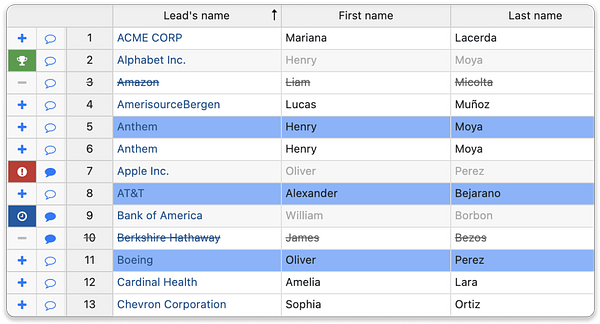 Built-in Prospecting
Built-in Prospecting
Use built-in prospecting to generate more leads for your business by importing lists from Excel or CSV files.
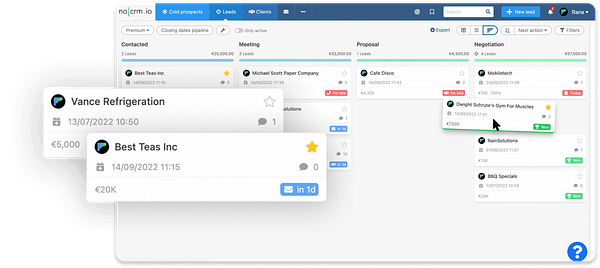 Customize Your Pipeline
Customize Your Pipeline
Organize your sales process with a customizable sales funnel and create as many pipelines as your business needs.
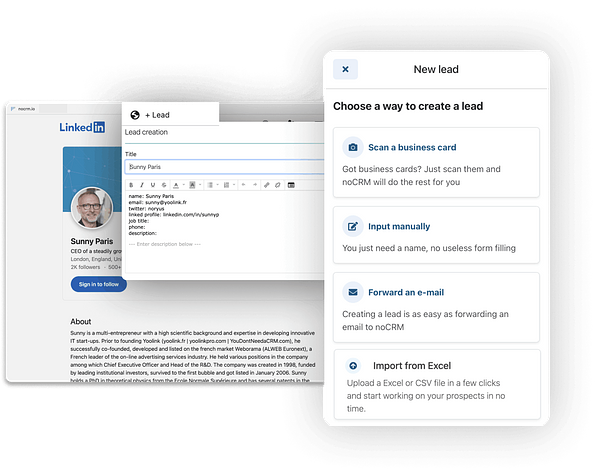 Capture Leads From Everywhere
Capture Leads From Everywhere
Capture leads from LinkedIn, web forms, emails and business cards with one click.
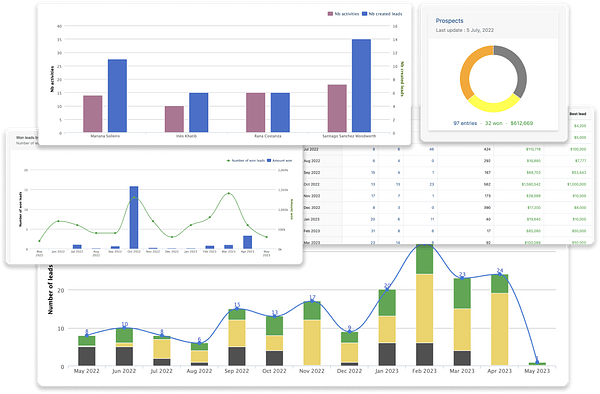 Statistics & Reporting
Statistics & Reporting
Get the details behind the deals with in-depth insights into company performance.
Track emails sent, calls made, deals closed and much more.
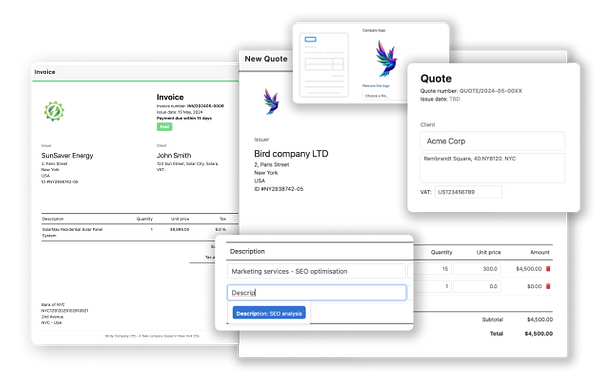 Quotes & Invoices
Quotes & Invoices
Manage your sales documents effortlessly with customizable quotes and invoices, and track their status in real time.
 Call & Messaging Integrations
Call & Messaging Integrations
Streamline communication with integrated email, WhatsApp, and VoIP solutions to track, engage, and convert leads efficiently.
sales team